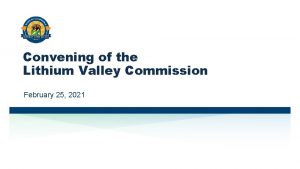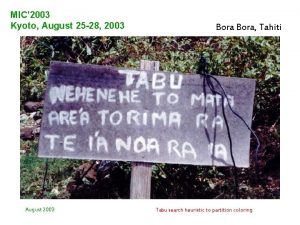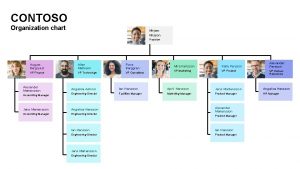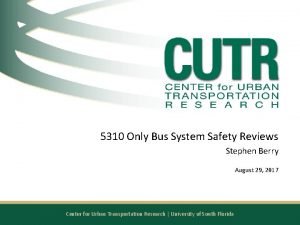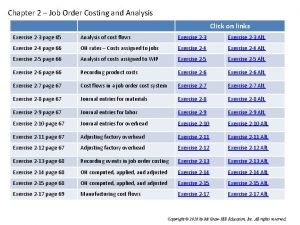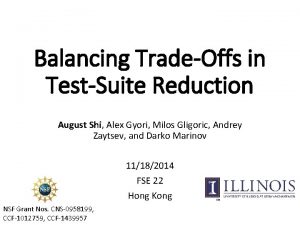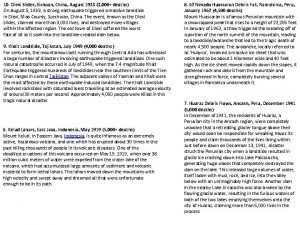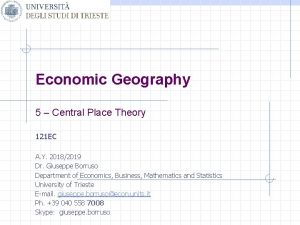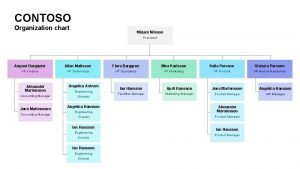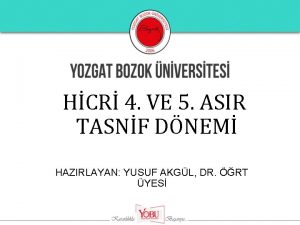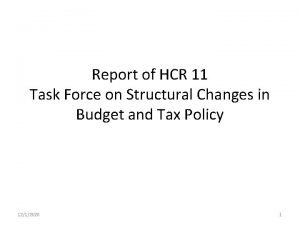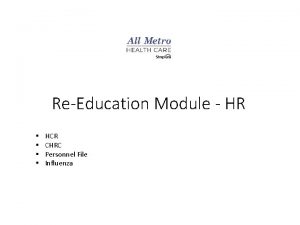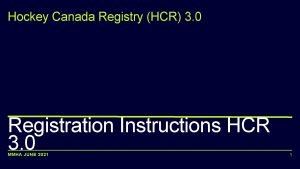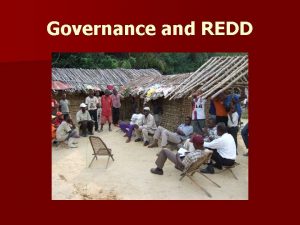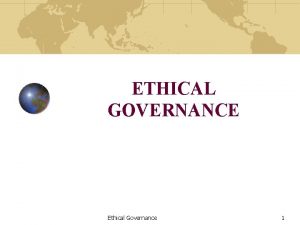Governance Commission Meeting 1 August 19 2011 HCR








































































- Slides: 72

Governance Commission Meeting 1 August 19, 2011

HCR 184 • . . . creates a commission to study governance, management, and supervision of postsecondary education. The resolution states that governance has been a perennial issue faced by the legislature since the adoption of the current constitution and there is general agreement in the legislature that there are problems with the current structure but no general agreement on a solution. Louisiana’s governance structure should provide strong policy leadership, drive institutional accountability and student achievement. The resolution further states that it is logical, reasonable, and imperative that postsecondary education institutions work within a cohesive and comprehensive governance framework that maximizes the application of scarce resources to the benefit of their students.

HCR 184 The resolution sets out specific tasks for the Commission resulting in two primary charges. PART ONE: The Study The Commission shall conduct a study that includes the examination of how an improved governance structure would result in: • More efficient use of resources by eliminating duplicative management arrangements and personnel • The improvement of student success by better alignment of student interests and abilities with appropriate institutions and credential options • Better integration of education at all secondary and postsecondary levels through development of a complete articulation and transfer plan • More fair and equitable service to all institutions through better representation in the management structure and fuller recognition and support for the special missions and needs of historically black colleges and universities

HCR 184 PART TWO: The Plan for Reorganization The commission shall prepare and submit to the legislature a plan for reorganization of the governance, management, and supervision of postsecondary education, which shall include not only a proposal for a basic structural arrangement of entities, offices, and institutions but also: • Evaluation and conclusion regarding creation of a single board to govern public postsecondary institutions • A detailed articulation of the distribution of authority and responsibilities among entities, offices, and institutions • Recommendations for the proper mechanism for setting tuition and suggestions regarding the proper balance of state general funds and tuition as means of funding postsecondary education • Proposals regarding the distribution formula of state general funds and the relative importance of equity and performance in that formula Timeline • The resolution states that the Commission is to submit a plan for reorganization to the legislature not later than sixty (60) days prior to the 2012 Regular Session of the Legislature of Louisiana which begins on March 12, 2012.

Authors • Representative Carmody • Representative Schroder

Louisiana’s Public Colleges and Universities LSU Health Sciences Center - Shreveport Bossier Parish Community College Louisiana Tech University Grambling State University of Louisiana Monroe Louisiana Technical College (7 colleges statewide) Louisiana Delta Community College Southern University- Shreveport LSU - Alexandria LSU-Shreveport Louisiana State University Northwestern State University Southern University Baton Rouge Community College Southeastern Louisiana University Mc. Neese State University of New Orleans SOWELA Technical Community College LSU - Eunice South Louisiana Community College University of Louisiana Lafayette Fletcher Technical Community College Nicholls State University River Parishes Community College Delgado Community College Southern University Nunez New Orleans Community College LSU Health Sciences Center - New Orleans

Annual Enrollment for Public Institutions 250 000 225 000 200 000 175 000 195 380 198 016 FY 2007 FY 2008 207 760 220 583 225 198 FY 2010 FY 2011 177 230 150 000 125 000 100 000 FY 2006 FY 2009 62% are enrolled in universities 11% are graduate students 59 % are women 30% are African-American 10% are out-of state and international students 7

First-Time Freshman Enrollment Mix 100% 90% 80% 79% 70% 56% 60% 44% 50% 40% 30% 20% 10% 21% 0% Fall 2000 Fall 2001 Fall 2002 Fall 2003 Four-Year Fall 2004 Fall 2006 Fall 2007 Fall 2008 Fall 2009 Two-Year/Technical Fall 2010

Matriculation Rates One –Year Retention Rates University: 72% Community college: 47% Graduation rates: University (6 -year rate): 42% Community college (3 -year rate): 6%

Student Preparation for College • Average ACT for Louisiana is 20. 7 compared to 22 for the Nation as a whole • 72% of entering freshmen at community colleges need remediation • 21% of Entering freshmen at the universities need remediation • State minimum admission standards will redirect all students needing developmental education to the community colleges by 2014.

Certificates and Degrees Awarded 1% Doctoral 13% Master's 51% Bachelor's 13% Associate 11% Certificates 8% Diplomas 0% 10% 20% 30% 40% 50% 60%

Certificates and Degrees Awarded 45 000 40 000 35 000 30 000 382% - Certificates 55% - Diplomas 51% Associate Degrees 8% Baccalaureate Degrees -2% Master Degrees 5% Doctoral Degrees 38 425 25 000 20 000 e s a e r c n 28% I 15 000 10 000 5 000 - FY 2006 FY 2007 FY 2008 FY 2009 FY 2010 FY 2011 12

Sources of Revenue ARRA funds are included in “Other” for FY 2010 and FY 2011.

Student Aid TOPS, State Need-Based Aid, Institutional Scholarships, Student Loans (in $millions) $1 100 1020, 1 $1 000 $900 826, 3 $800 756, 9 $700 616, 7 $600 $500 $400 $300 $200 $100 110, 5 74, 5 $0 81, 7 129, 9 120, 6 136, 5 03 TOPS 27, 4 25, 2 1 02 144, 4 04 05 State Need-Based Aid 06 07 08 Institutional Scholarships 09 10 Student Loans 11

Performance Initiatives • Performance Funding Formula • Grad Act • Articulation transfer degree • Increase admission standards for universities • Academic Program review – termination of underperforming programs

16

17

18

19

20

21

22

23

24

25

26

27

28

29

30

31

32

33

34

35

36

37

38

39

40

41

42

43

44

45

46

47

48

Slate. com 49

22% 9. 7% 50

A Little History of the World E. H. Gombrich • Anyone who owned a mechanical loom could, with the help of one or two assistants – perhaps his wife and children – do more work than a hundred trained weavers. • So whatever became of all the weavers in a town into which a mechanical loom was introduced? . . . they woke up one day to discover that they weren’t needed any more. Everything it had taken them years to learn, first as apprentices and then as journeymen, was useless. Compression of wages Restructuring of the economy Those that adapt flourish Those that could not. . . 51

• In 1970, 74% of the middle class had a high school diploma or less education. • In 2007, only 39% of middle class had a high school diploma or less education. • Middle Class: – Family income range from 35, 000 to 91, 000

• Help Wanted – Projections of Jobs and Education Requirements through 2018. Carnevale, Smith and Strohl • “postsecondary education has become the gatekeeper to the middle class and the upper class”

Nationally, 60% of jobs will require a postsecondary credential by 2018. What was said about Louisiana: • By 2018, more than 50% of jobs will require a postsecondary credential. Louisiana currently has a workforce with less than half of what will be needed. • Unless there are systemic changes, in 2018 Louisiana will:

• rank 6 th in the nation in the percentage of jobs for high school dropouts; • rank 5 th in the nation in the percentage of jobs for high school graduates; • rank 50 th in the nation for jobs requiring an associate degree; • rank 45 th in the nation in the percentage of jobs for college graduates; • rank 47 th in the nation in the percentage of jobs for people with graduate degrees and. . .

• rank next to last in the percent of Jobs Requiring Postsecondary Education. We are at a turning point. Louisiana has to decide whether to do a better job at educating its people or serve as a great conveniently located source for cheap labor. What is our collective vision of what Louisiana will look like in the future?

30% 10% 3 Arkansas Louisiana Nevada West Virginia New Mexico Alaska Oklahoma Arizona Tennessee Texas Alabama Kentucky Mississippi Georgia Idaho South Carolina Wyoming Florida California Delaware Indiana Maine Michigan Montana North Carolina Ohio Oregon Missouri Utah Washington Wisconsin Colorado Hawaii Kansas Virginia Illinois Pennsylvania Rhode Island Nebraska South Dakota Vermont Maryland Connecticut Iowa New Hampshire New Jersey Minnesota New York North Dakota Massachusetts Current percentage of young adults (25 -34) with a college degree 3 55% 53% 50% 45% 40% 35% 28% 25% 20% 15% “College degree” means an associate degree, bachelor’s degree, or higher. National Center for Higher Education Management Systems (NCHEMS), 2008 57 (from U. S. Census Bureau, 2008 American Community Survey Public Use Microdata Sample File. ) http: //www. higheredinfo. org

La. La given ‘F’ in skilled workers Advocate business writer • The number and quality of skilled workers in Louisiana is dismal, according to a recent report evaluating the state’s manufacturing abilities. • The 2011 Manufacturing and Logistics National Report by the Center for Business and Economic Research at Ball State University in Indiana gave Louisiana a failing grade in the important area of “human capital. ” • All 50 states were included in the study.

Time and Place Those individuals, families, cities, states and – increasingly—countries with the most education are prospering, while those with the least higher education are experiencing relative and often absolute economic decline. --Postsecondary Education OPPORTUNITY, June 2005. For people and communities to thrive in the new economy they will need to have access to a good college and good health care.

Top 25 Cities for College Graduates 1. 2. 3. 4. 5. 6. 7. 8. 9. 10. 11. 12. 13. 14. 15. 16. 17. 18. 19. 20. 21. 22. 23. 24. 25. compiled by The Fayetteville, NC Daily Beast published Omaha, Neb. by Newsweek. Oklahoma City, OK Austin, TX Houston, TX Lexington, KY Durham, NC Dallas, TX Tulsa, OK Little Rock, AR Savannah, GA Washington D. C. Boston, MA Corpus Christi, TX Baton Rouge, LA New Orleans, LA Des Moines, Iowa Columbus, OH Stanford, Conn. Shreveport, LA Seattle, WA Albany, NY San Antonio, TX Kalamazoo, Michigan Honolulu, Hawaii

Percent of Parish Population With Bachelors and Higher---25 and older State Average 20. 64% 20. 0% - 32. 2% 12. 0% - 19. 9% 8. 3%- 11. 9% Source: Data Set: 2005 -2009 American Community Survey 5 -Year Estimates Survey

75% of persons with bachelor’s live in 8 parishes

63

Local Imperative • 81% of Louisianans were born in Louisiana • The local population will be your workforce • Student preparation for college/work is key • Local support for local students is needed • Getting adults with some college to complete their degree can be a strong mechanism for building local communities • Stewards of the community

Employment Rate by Degree Level Eighteen Months after Graduation - For All Completers 100% 90% 80% 70% 56, 4% 67, 6% 72, 5% 60, 5% 59, 5% 60% 50, 4% 50% 38, 3% 40% 30% 20% 10% 0% Certificate Diploma Associate Bachelor's 2006 -07 Master's 2007 -08 Doctoral Professional 2008 -09

Figure 5 Employment Rate by Field of Study Eighteen Months after Graduation - For 2008 -09 Bachelor’s Degree Completers 70% 69% 68% 67% 64% 63% 62% 61% 61% 57% 56% 53% 53% 52% 52% 47% 44% 43% 41% 38% 34% 29% Health Professions Education Engineering Technologies Family & Consumer Sciences Public Admin. & Social Service Transportation & Materials Moving Business, Management, Marketing Liberal Arts & Sci; General Studies Security & Protective Services Personal & Culinary Services Natural Resources & Conservation Architecture Communication, Journalism Agriculture, Agriculture Operations Computer & Information Sciences Psychology Social Sciences History Visual & Performing Arts English Language & Literature Engineering Mathematics and Statistics Legal Professions Foreign Languages, Literatures Parks, Recreation, Leisure, Fitness Biological & Biomedical Sciences Multi/Interdisciplinary Studies Physical Sciences Philosophy & Religious Studies 0% 10% 20% 30% % Found Employed in LA 30% 31% 32% 33% 36% 37% 38% 39% 39% 43% 44% 47% 47% 48% 48% 53% 56% 57% 59% 62% 66% 71% 40% 50% 60% % Not Found Employed in LA 70% 80% 90% 100%

Employment Rate by Residency Status Eighteen Months after Graduation - For All Completers (Collective 2006 -07, 2007 -08, and 2008 -09) LA Residents Max Degree Level Certificate Diploma Associate Bachelor’s Master’s Doctoral Professional Non-Residents Number of Completers Percent Found Employed 3, 900 60. 9% 74 27. 0% 6, 917 68. 8% 81 28. 4% 11, 126 73. 9% 261 26. 8% 46, 477 63. 8% 6, 071 22. 3% 9, 882 69. 2% 3, 228 22. 7% 590 55. 4% 794 15. 4% 2, 180 53. 0% 286 20. 3%

Figure 7 Employment Rate by Residency Status Eighteen Months after Graduation - For All Completers (Collective 2006 -07, 2007 -08, and 2008 -09) 80% 73, 9% 69, 2% 68, 8% 70% 63, 8% 60, 9% 60% 55, 4% 53, 0% 50% 40% 30% 27, 0% 28, 4% 26, 8% 22, 3% 20% 22, 7% 20, 3% 15, 4% 10% 0% Certificate Diploma Associate Bachelor's Louisiana Residents Master's Non-Residents Doctoral Professional

Table 5 Average Calculated Salary by Degree Level For All Employed Completers Max Degree Level Certificate Diploma Associate Bachelor Master Doctoral Professional Eighteen Months after Graduation 2006 -07 2007 -08 2008 -09 As a result of the recession, compression of wages for new hires has occurred. $23, 000 $24, 778 $23, 622 $30, 607 $30, 062 $28, 530 $37, 799 $37, 425 $35, 544 $35, 099 $34, 115 $32, 742 The trend in other $48, 737 $49, 644 $48, 016 $59, 863 $60, 655 $61, 023 $65, 368 $67, 315 $66, 786 states show that at five years in the workforce, bachelor’s degree recipients will earn more, on average, than associates.

Average Calculated Salary by Field of Study Eighteen Months after Graduation - For 2008 -09 Bachelor’s Degree Completers Engineering Health Professions Engineering Technologies Education Natural Resources & Conservation Computer & Information Sciences Business, Management, . . . Architecture Liberal Arts & Sci; General Studies Agriculture, Agriculture. . . Transportation & Materials. . . Physical Sciences Mathematics and Statistics Philosophy & Religious Studies Public Admin. & Social Service Security & Protective Services Multi/Interdisciplinary Studies History Foreign Languages, Literatures Parks, Recreation, Leisure, Fitness Family & Consumer Sciences Personal & Culinary Services Social Sciences English Language & Literature Communication, Journalism Biological & Biomedical Sciences Visual & Performing Arts Psychology Legal Professions $10 000 $56 853 $46 537 $43 787 $38 415 $34 605 $34 238 $32 326 $30 949 $29 055 $28 640 $27 461 $27 309 $27 229 $26 506 $26 237 $26 092 $25 740 $25 510 $25 144 $24 839 $24 323 $24 170 $23 866 $23 785 $23 572 $23 314 $22 418 $21 580 $21 420 $20 000 $30 000 $40 000 $50 000 $60 000 $70 000

Average Calculated Salary by Field of Study For 2008 -09 Associate Degree Completers Field Of Study Number of Completers Wages Eighteen Months after Graduation Agriculture, Agriculture Operations Biological & Biomedical Sciences Business, Management, Marketing Communication, Journalism Communications Technologies Computer & Information Sciences Education Engineering Technologies Family & Consumer Sciences Foreign Languages, Literatures Health Professions Legal Professions Liberal Arts & Sci; General Studies Mechanic & Repair Technologies Multi/Interdisciplinary Studies Natural Resources & Conservation Personal & Culinary Services Physical Sciences Security & Protective Services Visual & Performing Arts 2 2 429 12 26 88 53 396 52 6 957 19 555 20 22 4 32 3 161 39 --$25, 347 $20, 305 $17, 928 $28, 531 $25, 993 $49, 112 $18, 149 -$46, 784 $28, 572 $23, 584 $36, 430 $19, 352 -$27, 178 -$30, 031 $19, 001

At the end of WWII, the U. S made a bold decision to invest in the future of its economy by providing $1. 9 billion annually to the education of returning veterans of the war. This commitment to human capital helped enable the WWII generation to become the “greatest generation. ” Possibly, this state’s greatest generation is at the schoolhouse door waiting for the opportunity to propel your state into the global economy.
 Expressive aggression
Expressive aggression Hcr-20
Hcr-20 Full moon august 2011
Full moon august 2011 Graduated commission definition
Graduated commission definition Recommendation of secondary education commission
Recommendation of secondary education commission Lithium valley commission meeting
Lithium valley commission meeting Odfw commission meeting
Odfw commission meeting Today meeting or today's meeting
Today meeting or today's meeting What is meeting and types of meeting
What is meeting and types of meeting Types of meeting
Types of meeting Today meeting or today's meeting
Today meeting or today's meeting What happened on august 23 1939
What happened on august 23 1939 Agosto 13 1896
Agosto 13 1896 Leerexpert august leyweg 4
Leerexpert august leyweg 4 August lec 250
August lec 250 August hlond przepowiednie
August hlond przepowiednie Strindbergs fruar
Strindbergs fruar Chinese names and pronunciation
Chinese names and pronunciation šljivari august šenoa
šljivari august šenoa Colestaz
Colestaz A population of 250 birds inhabit the canopy
A population of 250 birds inhabit the canopy Three august ones
Three august ones Mirjam nillson
Mirjam nillson August safety
August safety August 26 2010
August 26 2010 Micro computer services began operations on august 1
Micro computer services began operations on august 1 Gottfried august bürger
Gottfried august bürger Anz definition
Anz definition Julie august
Julie august August 29, 1958
August 29, 1958 August alsina testimony zip
August alsina testimony zip August strindberg giftas
August strindberg giftas Dr ralph ferraro
Dr ralph ferraro August 27 2002
August 27 2002 August kiss
August kiss Móric beňovský anna zsuzsanna hönsch
Móric beňovský anna zsuzsanna hönsch August 16 1958
August 16 1958 September 23, 2017 plus 1335 days
September 23, 2017 plus 1335 days August robert ludwig macke
August robert ludwig macke Starr company reports the following information for august.
Starr company reports the following information for august. August wilson
August wilson August
August Carl jonas love almqvist kända verk
Carl jonas love almqvist kända verk Cnn 10 september 7
Cnn 10 september 7 It was late summer 26 august 1910
It was late summer 26 august 1910 Theme of betrayal in fences
Theme of betrayal in fences August shi
August shi April may june july
April may june july August shi
August shi 30th august 2005
30th august 2005 A gailiti romaan
A gailiti romaan August journal prompts
August journal prompts Propast venecije august šenoa
Propast venecije august šenoa Berlin weather august
Berlin weather august August safety topics
August safety topics Summary of light in august
Summary of light in august August kekulé
August kekulé Diexi slides
Diexi slides Timeline ng kaligirang pangkasaysayan ng el filibusterismo
Timeline ng kaligirang pangkasaysayan ng el filibusterismo Dr lorraine johnstone
Dr lorraine johnstone August strindberg faderen analyse
August strindberg faderen analyse 15 august 1769
15 august 1769 Fences central idea
Fences central idea Central place theory hexagon
Central place theory hexagon Tujuan mempelajari evolusi
Tujuan mempelajari evolusi 6 months before august 31
6 months before august 31 Povjestice postolar i vrag
Povjestice postolar i vrag August alsina testimony album download
August alsina testimony album download Contoso pharmaceuticals
Contoso pharmaceuticals August stern
August stern Fences by august wilson characters
Fences by august wilson characters August prima porta
August prima porta Embriologi perbandingan
Embriologi perbandingan





